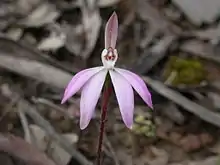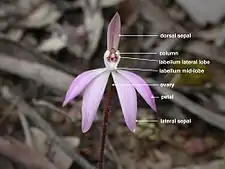Caladenia fuscata
Caladenia fuscata, commonly known as dusky fingers, is a plant in the orchid family Orchidaceae and is endemic to eastern and south-eastern Australia, including Tasmania. It is a small ground orchid found in eucalyptus woodland and which flowers in September and October.
| Dusky fingers | |
|---|---|
 | |
| C. fuscata growing on Black Mountain in the Australian Capital Territory | |
| Scientific classification | |
| Kingdom: | Plantae |
| Clade: | Tracheophytes |
| Clade: | Angiosperms |
| Clade: | Monocots |
| Order: | Asparagales |
| Family: | Orchidaceae |
| Subfamily: | Orchidoideae |
| Tribe: | Diurideae |
| Genus: | Caladenia |
| Species: | C. fuscata |
| Binomial name | |
| Caladenia fuscata | |
| Synonyms | |
| |
Description
Caladenia fuscata is a terrestrial, perennial, deciduous, herb with an underground tuber and a single, sparsely hairy, narrow linear leaf, 5–18 cm (2–7 in) long and 2–3 mm (0.08–0.1 in) wide.[2][3][4]
The single white or pink flower is borne on a spike up to 150 mm (6 in) high. The dorsal sepal is erect, linear in shape, 7–12 mm (0.3–0.5 in) long, 1–2 mm (0.04–0.08 in) wide with a pointed end. The lateral sepals and petals are usually 6–12 mm (0.2–0.5 in) long, about 2 mm (0.08 in) wide, with their outer surfaces densely covered with a band of short, reddish-brown glandular hairs. The labellum is egg-shaped, about 6 mm (0.2 in) long and wide, white or pinkish with three lobes and prominent red stripes. The mid-lobe is small and pointed with small teeth on the edge and several rows of yellow-tipped calli in the centre. The lateral lobes are prominent, broad and protrude past the mid-lobe. The column is 5–7 mm (0.2–0.3 in) long, curves inwards and has narrow wings. Flowering occurs in September and October and is followed by a non-fleshy, dehiscent capsule containing a large number of seeds. It is similar to Caladenia carnea but is distinguished from it by its single flower, earlier flowering period and red stripes on the labellum and column.[2][3][4]

Taxonomy and naming
Caladenia fuscata was first formally described as Caladenia carnea var. fuscata by Heinrich Gustav Reichenbach in 1871.[5] It was raised to species status in 1989 by David Jones and Mark Clements.[1] The specific epithet (fuscata) is derived from the Latin word fusca meaning "brown"[6] in reference to the brownish coloration on the back of the sepals and petals.[7]
Distribution and habitat
Dusky fingers occurs in Queensland, New South Wales, Victoria, Tasmania and South Australia where it grows in open forest, woodland and coastal scrub in a range of soil types. It is mostly only found on the drier western side of the Great Dividing Range. It has also been recorded in New Zealand.[8]
References
- "Caladenia fuscata". APNI. Retrieved 20 September 2016.
- Jones, David L. (1998). "Contributions to Tasmanian Orchidology - 1". Australian Orchid Research. 3: 32.
- Bernhardt, Peter. "Caladenia fuscata". Royal Botanic Garden, Sydney: plantNET. Retrieved 20 September 2016.
- Jeanes, Jeffrey. "Caladenia fuscata". Royal Botanic Gardens Victoria: Vicflora. Retrieved 20 September 2016.
- "Caladenia carnea var. fuscata". APNI. Retrieved 20 September 2016.
- Brown, Roland Wilbur (1956). The Composition of Scientific Words. Washington, D.C.: Smithsonian Institution Press. p. 168.
- Clements, Mark Alwyn (1989). "Catalogue of Australian Orchidaceae". Australian Orchid Research. 1: 25.
- "Caladenia fuscata". NZ Native Orchid Group. Retrieved 20 September 2016.